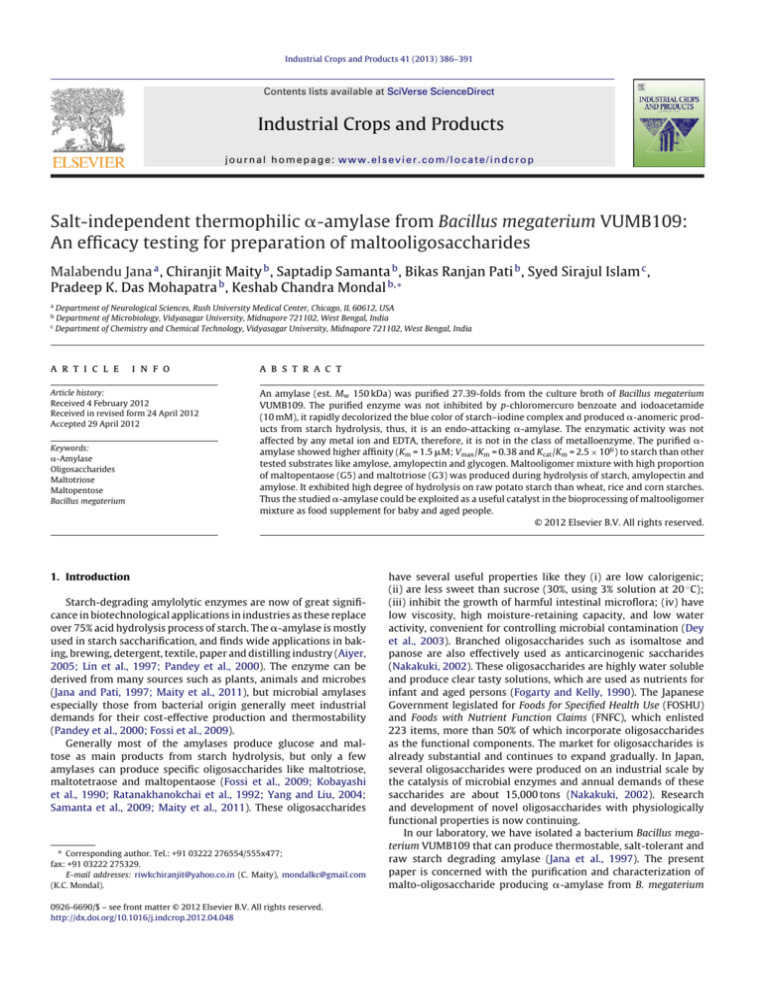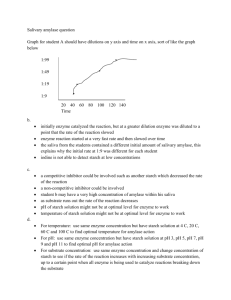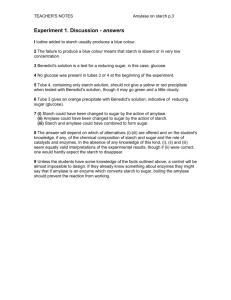
Industrial Crops and Products 41 (2013) 386–391
Contents lists available at SciVerse ScienceDirect
Industrial Crops and Products
journal homepage: www.elsevier.com/locate/indcrop
Salt-independent thermophilic ␣-amylase from Bacillus megaterium VUMB109:
An efficacy testing for preparation of maltooligosaccharides
Malabendu Jana a , Chiranjit Maity b , Saptadip Samanta b , Bikas Ranjan Pati b , Syed Sirajul Islam c ,
Pradeep K. Das Mohapatra b , Keshab Chandra Mondal b,∗
a
Department of Neurological Sciences, Rush University Medical Center, Chicago, IL 60612, USA
Department of Microbiology, Vidyasagar University, Midnapore 721102, West Bengal, India
c
Department of Chemistry and Chemical Technology, Vidyasagar University, Midnapore 721102, West Bengal, India
b
a r t i c l e
i n f o
Article history:
Received 4 February 2012
Received in revised form 24 April 2012
Accepted 29 April 2012
Keywords:
␣-Amylase
Oligosaccharides
Maltotriose
Maltopentose
Bacillus megaterium
a b s t r a c t
An amylase (est. Mw 150 kDa) was purified 27.39-folds from the culture broth of Bacillus megaterium
VUMB109. The purified enzyme was not inhibited by p-chloromercuro benzoate and iodoacetamide
(10 mM), it rapidly decolorized the blue color of starch–iodine complex and produced ␣-anomeric products from starch hydrolysis, thus, it is an endo-attacking ␣-amylase. The enzymatic activity was not
affected by any metal ion and EDTA, therefore, it is not in the class of metalloenzyme. The purified ␣amylase showed higher affinity (Km = 1.5 M; Vmax /Km = 0.38 and Kcat /Km = 2.5 × 106 ) to starch than other
tested substrates like amylose, amylopectin and glycogen. Maltooligomer mixture with high proportion
of maltopentaose (G5) and maltotriose (G3) was produced during hydrolysis of starch, amylopectin and
amylose. It exhibited high degree of hydrolysis on raw potato starch than wheat, rice and corn starches.
Thus the studied ␣-amylase could be exploited as a useful catalyst in the bioprocessing of maltooligomer
mixture as food supplement for baby and aged people.
© 2012 Elsevier B.V. All rights reserved.
1. Introduction
Starch-degrading amylolytic enzymes are now of great significance in biotechnological applications in industries as these replace
over 75% acid hydrolysis process of starch. The ␣-amylase is mostly
used in starch saccharification, and finds wide applications in baking, brewing, detergent, textile, paper and distilling industry (Aiyer,
2005; Lin et al., 1997; Pandey et al., 2000). The enzyme can be
derived from many sources such as plants, animals and microbes
(Jana and Pati, 1997; Maity et al., 2011), but microbial amylases
especially those from bacterial origin generally meet industrial
demands for their cost-effective production and thermostability
(Pandey et al., 2000; Fossi et al., 2009).
Generally most of the amylases produce glucose and maltose as main products from starch hydrolysis, but only a few
amylases can produce specific oligosaccharides like maltotriose,
maltotetraose and maltopentaose (Fossi et al., 2009; Kobayashi
et al., 1990; Ratanakhanokchai et al., 1992; Yang and Liu, 2004;
Samanta et al., 2009; Maity et al., 2011). These oligosaccharides
∗ Corresponding author. Tel.: +91 03222 276554/555x477;
fax: +91 03222 275329.
E-mail addresses: riwkchiranjit@yahoo.co.in (C. Maity), mondalkc@gmail.com
(K.C. Mondal).
0926-6690/$ – see front matter © 2012 Elsevier B.V. All rights reserved.
http://dx.doi.org/10.1016/j.indcrop.2012.04.048
have several useful properties like they (i) are low calorigenic;
(ii) are less sweet than sucrose (30%, using 3% solution at 20 ◦ C);
(iii) inhibit the growth of harmful intestinal microflora; (iv) have
low viscosity, high moisture-retaining capacity, and low water
activity, convenient for controlling microbial contamination (Dey
et al., 2003). Branched oligosaccharides such as isomaltose and
panose are also effectively used as anticarcinogenic saccharides
(Nakakuki, 2002). These oligosaccharides are highly water soluble
and produce clear tasty solutions, which are used as nutrients for
infant and aged persons (Fogarty and Kelly, 1990). The Japanese
Government legislated for Foods for Specified Health Use (FOSHU)
and Foods with Nutrient Function Claims (FNFC), which enlisted
223 items, more than 50% of which incorporate oligosaccharides
as the functional components. The market for oligosaccharides is
already substantial and continues to expand gradually. In Japan,
several oligosaccharides were produced on an industrial scale by
the catalysis of microbial enzymes and annual demands of these
saccharides are about 15,000 tons (Nakakuki, 2002). Research
and development of novel oligosaccharides with physiologically
functional properties is now continuing.
In our laboratory, we have isolated a bacterium Bacillus megaterium VUMB109 that can produce thermostable, salt-tolerant and
raw starch degrading amylase (Jana et al., 1997). The present
paper is concerned with the purification and characterization of
malto-oligosaccharide producing ␣-amylase from B. megaterium
M. Jana et al. / Industrial Crops and Products 41 (2013) 386–391
VUMB109. This amylase is quite different with respect to the product specificity from the amylases produced by other strains of B.
megaterium (Ghollasi et al., 2010; Takasaki, 1989).
2. Materials and methods
2.1. Microorganism
Previously isolated and identified B. megaterium VUMB109 (Jana
et al., 1997) was used in this study.
2.2. Submerged fermentation
An enriched culture media (pH ∼8.2) containing (w/v) 0.2%
starch, 0.4% (NH4 )2 HPO4 , 0.05% MgSO4 ·7H2 O and 0.1% KCl was used
for submerged fermentation. Enzyme production was carried out
in a 250 ml flask containing 50 ml liquid media for 24 h at 40 ◦ C on a
rotary shaker (200 rpm). Fermented broth was collected after centrifugation (5000 × g for 10 min) and the resultant supernatant was
used as the source of enzyme.
2.3. Purification of the amylase
The concentrated culture broth was treated with solid
(NH4 )2 SO4 (80% saturation) and kept at 4 ◦ C for 12 h. The precipitate
was collected by centrifugation (12,000 × g for 30 min, at 4 ◦ C) and
dissolved in phosphate buffer (10 mM, pH 7.75). Enzyme solution
was dialyzed against the same buffer for 24 h at 4 ◦ C with a periodical change of the buffer solution. The dialyzed enzyme was passed
through a DEAE-cellulose column (Merck, Mumbai, India). The
active fraction of amylase was eluted with a linear gradient of KCl
(0.001–0.2 M). Then the enzyme was passed through Sephadex G100 column (1.5 cm × 92 cm) that was pre-equilibrated with 10 mM
phosphate buffer (pH 7.5) and eluted with the same buffer. The
active fractions were collected, concentrated through lyophilization and kept at 4 ◦ C for further use.
The homogeneity of the purified amylase was tested through
SDS-polyacrylamide (12%) gel electrophoresis according to the
method of Laemmli (1970). After electrophoresis, the gel was
stained with coomassie brilliant blue (R250) and the molecular
weight of the amylase was determined against marker proteins
(Genei, Bangalore, India).
387
Martins (2000). The substrate solution of 1.0 ml [1% (w/v) soluble starch (Himedia, Mumbai, India) in phoshphate buffer, 0.02 M,
pH 7.2] was incubated with 0.1 ml of the enzyme at 90 ◦ C for
30 min. Enzymatic reaction was periodically stopped by adding
10 ml of 0.1 N HCl. Then this solution was diluted 10 times with
iodine reagent (0.05% iodine and 0.5% potassium iodide) and the
absorbance was measured at 660 nm.
2.7. Measurement of optical rotation of hydrolyzed products
The purified amylase was employed for complete hydrolysis
of potato starch. A reaction mixture (1 ml) consisting of 1% (w/v)
starch solution in 10 mM phosphate buffer (pH 7.75) and 100 l
of purified amylase was added to 1 cm cell (cuvette). The optical
rotation of the mixture was periodically measured in polarimeter (Perkin Elmer) using sodium light. The mutarotation of the
hydrolysate was determined by adding 5.0 mg of solid sodium carbonate per milliliter of mixture after the optical rotation became
almost constant (Konsula and Liakopoulou-Kyriakides, 2004).
2.8. Degree of hydrolysis of starchy foods
Different starchy foods (1%, w/v in phosphate buffer, pH 7.75)
like wheat, potato, rice and corn were separately mixed with
enzyme solution (1.0 U/ml) and incubated at 90 ◦ C. Acid hydrolysis
was carried out by treating the food stuffs with 6.0 M HCl at 100 ◦ C
for 2 h. Total reducing sugar as maltose equivalents was estimated
by DNS method (Dubois et al., 1956).
Degree of hydrolysis (%)
=
reducing sugar produced by enzyme hydrolysis
reducing sugar produced by acid hydrolysis
2.9. Chromatographic studies for product identification
Soluble protein was estimated following the procedure of Lowry
et al. (1951) using bovine serum albumin (fraction V) as the standard.
The enzymatic hydrolyzed products of different polysaccharides
were detected on 1 mm Whatman no. 1 chromatographic paper.
Starch, amylase and amylopectin [1 g% (w/v) in 10 mM phosphate
buffer, pH 7.5] were digested with the purified amylase at 93 ◦ C
and the periodic hydrolytic products (100 l) were spotted on
the papers. For identification of hydrolyzed products, the maltooligosaccharide marker (Sigma, USA) was employed. A descending
mode of solvent system of n-butanol–acetic acid–water (4:1:5,
v/v) was used for paper chromatography. Chromatogram was
developed by dipping the papers in alkaline silver nitrate/sodium
hydroxide reagent (1.2% AgNO3 + 0.1% KOH + 5% Na2 S2 O3 ).
The quantity of maltooligosaccharides in the enzymatic
hydrolyzate was determined in thin layer chromatography following the principle of HPTLC. For thin layer chromatography,
Merck classical silica TLC plate (silica gel 60 on aluminum backed,
10 cm × 20 cm) was used. 10 l of sample was spotted on activated
plate and dried with hair drier. The plates were then dipped in the
twin trough chamber with solvent system of n-butanol, methanol
and 16% (v/v) aqueous ammonia (5:4:3). After 10 min of run, plates
were dried and the oligosaccharides were stained by spraying a
mixture of 2.4% (w/v) phosphomolybdic acid, 5% (v/v) H2 SO4 and
1.5% (v/v) H3 PO4 . In similar manner known quantities of different
oligosaccharides (Sigma, USA) were also run simultaneously. The
quantity of each oligosaccharide was estimated through scanning
densitometry study using Immage Lab 2.0 software (Bio Rad) and
expressed as relative percentage.
2.6. Determination of blue loss percentage of starch
2.10. Estimation of kinetic parameters
The reduction in starch–iodine color intensity upon enzyme
hydrolysis was determined following the method of Teodoro and
The kinetic parameters of purified amylase like Km and Vmax
were estimated from Eadie–Hofstee plot (v0 vs. v0 /[s]) using
2.4. Assay of amylase
Saccharification activity of amylase was measured following
the method of Achi and Nijoku-Obi (1992). Briefly, reaction mixture contained 0.5 ml of 1% (w/v) soluble starch, 0.4 ml of 10 mM
phosphate buffer (pH 7.75) and 0.1 ml of enzyme solution. Then
the mixture was incubated at 93 ◦ C for 5 min. The liberated
reducing sugar in the reaction mixture was quantified using 3,5dinitrosalicylic acid (DNS) as coloring reagent and absorbance was
measured at 540 nm. One unit of enzyme activity was defined as the
amount of enzyme that released 1 mol reducing sugars (measured
as glucose) ml−1 min−1 under the specified assay conditions.
2.5. Estimation of protein
388
M. Jana et al. / Industrial Crops and Products 41 (2013) 386–391
Table 1
Summary of the purification of ␣-amylase from the culture broth of B. megaterium VUMB109.
Purification steps
Volume (ml)
Total activity (Units)
Crude extract
Ammonium sulfate precipitation
DEAE cellulose Chromatography
Sephadex G-100 chromatography
100
4.00
4.00
4.00
2000.0
1800.0
1712.0
768.6
enzyme kinetics software v1.3 (Sigmaplot, USA). The rate of reaction (v) was expressed as the number of micromoles of reducing
sugar (as glucose equivalents) released in 1 min by 1 mg of total
protein in the enzyme sample.
Total protein (mg)
228
48.92
28
3.2
Specific activity (U mg−1 )
Purification fold
8.77
36.79
61.14
240.19
1
4.19
6.97
27.39
Yield (%)
100
90
85.6
38.43
from B. megaterium VUMB109 was much higher compared to
other bacterial ␣-amylases (Takasaki, 1989; Ghollasi et al., 2010).
These data are in accordance with the amylase from Lactobacillus
amylovorus reported by Imam et al. (1991).
3. Results and discussion
3.2. Effect of metal ions and other effectors
3.1. Purification of the amylase
The successive recovery of enzyme from the fermented broth by
various steps of purification is shown in Table 1. At the final stage,
the enzyme was purified about 27.39 folds with a specific activity
of 240.19 U mg−1 and 38.43% yield. Though the traditional methods
gave lower yield, yet it was much better and comparable than other
advanced methods like chromato-focussing and HPLC techniques
(Rao et al., 2002; Shaw et al., 1995). The purification of ␣-amylase
from microbial source in most cases has involved sequential
chromatographic techniques after crude isolation by precipitation
and membrane separation. In these steps, a considerable amount
of enzyme is lost due to autolysis and some remain physically
adsorbed on the matrix. To overcome these constrains, single step
purification systems like affinity chromatography, counter current chromatography, expanded bed chromatography, etc., are now
been employed (Sivaramakrishnan et al., 2006), but the homogeneity of the purified enzyme was less than conventional methods (Rao
et al., 2002).
The molecular weight of the amylase was estimated to be
150 kDa in SDS-PAGE (Fig. 1). The molecular weight of the amylase
Metal ions are produced from corrosion of equipment, specially
when subjected to acid hydrolysis, or catalytic reaction is carried
out in the harsh environment. Apart from this, any requirement of
co-factor for enzymatic activity is also evaluated. So, the effect of
some metal ions at the different concentrations on the activity of
␣-amylase was investigated. The data depicted in Table 2 do suggest that no metal ion has significant stimulatory effect on enzyme
activity. Mg2+ , Sn2+ and K+ enhanced enzyme activity was in little
amounts. However, heavy metal ions like Hg2+ , Cu2+ , Fe3+ , Mn2+ ,
and Zn2+ completely inhibited the enzyme activity at concentration of 10 mM (Table 2). Such metal-independent amylase activity
was also noted in the literature (Malhotra et al., 2000; Ghollasi
et al., 2010). Normally, thermostable amylases are Ca2+ dependent
(Koch et al., 1991) but our amylase was quite unlike those as its
optimum temperature was 93 ◦ C (Jana et al., 1997) and not Ca2+
dependent. This is further established that presence of EDTA in the
reaction mixture did not drastically affect the enzymatic activity
(Table 2). Ca2+ independent thermostable ␣-amylase is advantageous in starch saccharification, as because there is no need of
Ca2+ removal from the product streams by using ion-exchangers
(Malhotra et al., 2000).
It was also reflected in Table 2 that iodoacetamide and pchloromercuro benzoate had no inhibitory effect on the activity of
␣-amylase. This property is the reverse to the characteristic of amylase. The activity of this enzyme was enhanced in the presence
of -marcaptoethanol and glutathione by 45% and 10%, respectively (Table 2). This indicated that the enzyme from B. megaterium
VUMB109 was not a type of -amylase.
3.3. Percentage of blue loss
It was observed that the amylase rapidly reduced the
starch–iodine color (Fig. 2). This indicated that the enzymatic attack
is endolytic in nature. Akerberg et al. (2000) opined that amylolysis of starch by the exo-attacking enzymes was accompanied by a
relatively little reduction of the iodine staining capacity of the substrate. But the present study indicated that rapid loss of percentage
of starch–iodine color was due to multiple attacks on substrate by
the enzyme.
3.4. Anomeric form of the hydrolyzed products
Fig. 1. SDS-PAGE (12%) analysis of amylase from the concentrated culture broth
(lane Ca), Sephadex G100 chromatography (lane Pa) with protein markers (Genei,
Bangalore, India) (lane M).
The optical rotation of starch hydrolyzed products was shifted
downward (Fig. 3), indicating that hydrolyzed products have an
␣-anomeric configuration. This study confirmed that the studied
enzyme belonged to ␣-amylase family. Similar types of findings
of anomeric product formation were observed by Kobayashi et al.
(1990) and Anindyawati et al. (1998).
M. Jana et al. / Industrial Crops and Products 41 (2013) 386–391
3
Table 2
Effect of metal ions and inhibitors on the activity of purified ␣-amylase. Purified
amylase (0.5 ml) was incubated with different concentration of metal salts and
0.01 M of each inhibitor in 0.2 M of phosphate buffer (pH 7.75) at 4 ◦ C for 30 min,
and then residual activities were assayed under the standard conditions.
+
Relative
activity (%)
Stimulation or
(inhibition) %
No metal ions
100
–
0.1
1
10
127
100
0
27
0
Cu2+
0.1
1
10
105
95
0
5
(5)
0
Ca2+
0.1
1
10
100
94
98
96
16
(6)
(2)
(4)
(84)
Hg2+
0.1
1
68
0
(32)
0
Pb2+
0.1
1
10
90
80
0
(10)
(20)
0
0.1
1
10
116
116
49
16
16
(51)
K+
0.1
1
10
108
108
114
8
8
14
Mg2+
0.1
1
10
114
114
116
14
14
16
Fe3+
0.1
1
10
87
81
0
(13)
(19)
(0)
Mn2+
0.1
1
10
93
87
0
(7)
(13)
(0)
Zn2+
0.1
1
10
84
84
0
(16)
(16)
(0)
102
115
140
90
96
2
15
40
(10)
(4)
Ag
Sn2+
Inhibitors (0.01 M)
p-Chloro-mercuro benzoate
Glutathione
-Marcaptoethanol
Iodoacetamide
EDTA
2.5
Optical rotation (degree)
Control
Concentration
(mM)
389
R 2 = 0.8905
2
1.5
1
0.5
0
0
5
10
15
20
Reaction time (min)
25
30
Fig. 3. Optical rotation of starch hydrolysate by the action of ␣-amylase from B.
megaterium VUMB109. Details of procedure mentioned in Section 2.
3.5. Action pattern of the enzyme
The kinetic parameters of purified ␣-amylase were determined
by Eadie–Hofstee plot, which is more suitable and reliable (not
involving reciprocal data) to estimate the kinetic constants than the
Lineweaver–Burk reciprocal plot. The substrate with the lowest Km
value and high Vmax /Km ratio has the highest apparent affinity of
the enzyme or is considered to be the best substrate. It is evident
from Fig. 4 that the purified amylase from B. megatarium VUMB109
showed lowest Km (1.5 M) and highest Vmax /Km ratio (0.38) for
starch than amylopectin, amylose and glycogen. The Kcat (turn
over number) and second order rate constant, Kcat /Km ratio of the
enzyme for starch were 3.8 × 106 (s−1 ) and 2.5 × 106 (mM−1 s−1 )
respectively. These values are also comparatively higher than the
other tested substrates. All the tested kinetic parameters indicated
that starch is the best substrate and the amylase is catalytically
more efficient in presence of this substrate.
Action pattern of the purified amylase on soluble starch,
amylose and amylopectin has been studied through paper chromatography (Fig. 5). Chromatogram indicated that major hydrolytic
products were maltohexaose (G6), maltopentaose (G5), maltotetraose (G4), maltotriose (G3) and maltose (G2). Maltose and
Loss of iodine colour (%)
100
80
60
40
R2 = 0.9917
20
0
0
5
10
15
20
Time (minute)
25
30
Fig. 2. Reduction in iodine staining power of starch by the action of purified amylase
from B. megaterium VUMB109 at 90 ◦ C and pH 7.2.
Fig. 4. Eadie–Hofstee plot for determination of Vmax (intercept on the v axis), Km
(slope of the plot), Vmax /Km (intercept on the v/s axis) and other kinetic parameters
of purified ␣-amylase for various substrates.
390
M. Jana et al. / Industrial Crops and Products 41 (2013) 386–391
Fig. 5. Paper chromatographic analysis of the hydrolyzed products of starch, amylose and amylopectin by the action of purified ␣-amylase of B. megaterium. The reaction
mixture contained I % substrate in 10 mM phosphate buffer (pH 7.5) at 93 ◦ C and samples were taken at various time intervals. Solvent system was n-butanol–acetic acid–water
4:1:5 (upper phase). Spots were resolved by silver nitrate staining.
maltotriose were not further hydrolyzed into glucose (G1). This
indicated that the enzyme randomly attacked the bonds in the
inner region of polysaccharides and produced various maltooligosaccharides. The enzyme was unable to hydrolyze pullulan or
␣-cyclodextrin as substrate (data not shown).
Quantity of malto-oligomers produced from different polysaccharides by the enzymatic attack was represented in Table 3. Upon
hydrolysis, amylopectin produced G3 (15%) and G5 (33%), but from
amylose and starch hydrolysis, different proportions of G3 (∼30%)
and G5 (∼40%) were liberated. Quantities of maltotriose (G3) and
maltopentaose (G5) were always higher in respect of the other
hydrolytic products when ␣-amylase reacted upon starch, amylose
and amylopectin. Generally ␣-amylase on starch hydrolysis yielded
higher quantity of G3 (Aiyer, 2005; Yang and Liu, 2004), but the
studied amylase produced higher quantity of G5 than G3. There was
also evidence of G4 product dominating amylase (Murakami et al.,
2008). The maltooligomer mix dominated by G3 and G5, having
tremendous importance in food industry specially, is used as a substitute of sucrose and other saccharides in baby and aged peoples
food.
our recent publication, we have also reported an ␣-amylase from
Bacillus thuringiensis CKB19 able to hydrolyze raw potato starch
more quickly than other raw starches (Maity et al., 2011). Hydrolysis of raw starch at sub-gelatinization temperatures (100–110 ◦ C)
has gained importance in consideration of factors like energy
costs, utilization of natural resources and viscosity problems
(Sivaramakrishnan et al., 2006). It turns out to be an economically
superior alternative to the conventional processes, which use pregelatinized starch as substrate. Goyal et al. (2005) reported that
a thermostable ␣-amylase from Bacillus sp. hydrolyzed 12.5 g% of
raw potato starch within 12 h. Iefuji et al. (1996) reported that
␣-amylase from Cryptococcus sp. S-2 exhibited a stronger digestibility toward raw potato starch and weaker activity for wheat, corn,
rice and sweet potato starches. So, the studied enzyme can be
made useful in the bioprocessing of starchy vegetables and other
food-stuffs.
3.6. Digestion of raw starchy foods by purified ˛-amylase
The degree of hydrolysis of rice, potato, wheat and corn starch
by the purified enzyme was studied (Fig. 6). The result showed
that the potato starch which is normally resistant to enzymatic
hydrolysis, degraded more rapidly than other three starchy foods
e.g., rice, wheat and corn (Fig. 6). There are many evidences of
the occurrence of potent amylase inhibitors in potato and wheat
(Rekha and Padmaja, 2002; Valencia-Jiménez et al., 2008), but the
studied amylase was not affected by these types of inhibitors. In
Table 3
Comparison of hydrolysis of different polysaccharides by the purified amylase from
B. megaterium VUMB109 (detail mentioned in Section 2). The hydrolyzed products
are represented as their proportional level (%).
Substrates
Starch
Amylose
Amylopectin
Product distribution (%)
G2
G3
G4
G5
G6
Higher oligomers
14
15
4.6
30
31
15
10
11
12
40
41
33
6
1.2
1
ND
0.8
34.4
Fig. 6. Digestion of various raw starches by the action of ␣-amylase from B. megaterium VUMB109 at 90 ◦ C. The amount of reducing sugar generated was measured
following the method Dubois et al. (1956).
M. Jana et al. / Industrial Crops and Products 41 (2013) 386–391
4. Conclusion
Much work has been done on ␣-amylase production from
microbial origin but little has been stated on its specific productforming property. The ␣-amylase from B. megaterium VUMB109 is
unique in respect of its characteristics and mode of action. The novel
characters of this enzyme are that (i) it is highly thermotolerant
but not metal dependent, (ii) it produced G3 and G5 as the major
hydrolytic products (G5 > G3) from different linear and branched
plant polysaccharides, and (iii) it showed high degree of hydrolysis
of raw potato starch, which is generally resistant to amylase action.
Acknowledgement
The authors are indebted to the Director, DIPAS, DRDO, Govt. of
India for financial support under the Task project.
References
Achi, O.K., Nijoku-Obi, A.N.U., 1992. Production of a raw starch saccharifying amylase
by Bacillus alvei grown on different agricultural substrates. World Journal of
Microbiology and Biotechnology 8, 206–207.
Aiyer, P.V., 2005. Amylases and their applications. African Journal of Biotechnology
4, 1525–1529.
Akerberg, C., Zacchi, G., Torto, N., Gorton, L., 2000. A kinetic model for enzymatic
wheat starch saccharification. Journal of Chemical Technology & Biotechnology
75, 306–314.
Anindyawati, T., Melliawati, R., Ito, K., Lizuka, M., Minamjura, N., 1998. Three different types of ␣-amylases from Aspergillus awamori Kt-11: their purifications,
properties, and specificities. Bioscience, Biotechnology, and Biochemistry 62,
1351–1357.
Dey, G., Singh, B., Banerjee, R., 2003. Immobilization of exo-amylase production
by Bacillus circulans GRS 313. Brazilian Archives of Biology and Technology 46,
167–176.
Dubois, M., Gilles, K.A., Hamilton, J.K., Rebers, P.A., Smith, F., 1956. Colorimetric
method for determination of sugars and related substances. Analytical Chemistry 28, 350–356.
Fogarty, W.M., Kelly, C.T., 1990. Recent advances in microbial amylases. In: Fogarty,
W.M., Kelly, C.T. (Eds.), Microbial Enzymes and Biotechnology, vol. 17b, 2nd ed.
Elsevier Science Publishers, New York, pp. 71–132.
Fossi, B.T., Tavea, F., Jiwoua, C., Ndjouenkeu, R., 2009. Screening and phenotypic
characterization of thermostable amylases producing yeasts and bacteria strains
from some Cameroonian soils. African Journal of Microbiology Research 3,
504–514.
Ghollasi, M., Khajeh, K., Naderi-Manesh, H., Ghasemi, A., 2010. Engineering of a
Bacillus ␣-amylase with improved thermostability and calcium independency.
Applied Biochemistry and Biotechnology 162, 444–459.
Goyal, N., Gupta, J.K., Soni, S.K., 2005. A novel raw starch digesting thermostable
␣-amylase from Bacillus sp. I-3 and its use in the direct hydrolysis of raw potato
starch. Enzyme and Microbial Technology 37, 723–734.
Iefuji, H., Chino, M., Kato, M., Iimura, Y., 1996. Raw starch-digesting and thermostable
␣-amylase from the yeast Cryptococcus sp. S-2: purification, characterization,
cloning and sequencing. Biochemical Journal 318, 989–996.
Imam, S.H., Burgess-Cassler, A., Cote, G.L., Gordon, S.H., Baker, F.L., 1991. A study of
cornstarch granule digestion by an unusually high molecular weight ␣-amylase
secreted by Lactobacillus amylovorus. Current Microbiology 22, 365–670.
Jana, M., Chattopadhyay, D.J., Pati, B.R., 1997. Thermostable, high salt-tolerant amylase from Bacillus megaterium VUMB109. Acta Microbiologica et Immunologica
Hungarica 44, 281–289.
391
Jana, M., Pati, B.R., 1997. Thermostable, salt tolerant ␣-amylase from Bacillus sp. MD
124. Journal of Basic Microbiology 37, 323–326.
Kobayashi, S., Okemoto, H., Hara, K., Hashimoto, H., 1990. Preparation and some
properties of a novel maltopentaose forming enzyme of Pseudomonas species.
Agricultural and Biological Chemistry 54, 147–156.
Koch, R., Lemka, K., Antranikian, G., 1991. Purification and properties of a hyperthermophilic ␣-amylase from the archaebacterium Pyrococcus woesei. Archives
of Microbiology 155, 572–578.
Konsula, Z., Liakopoulou-Kyriakides, M., 2004. Hydrolysis of starches by the action
of an ␣-amylase from Bacillus subtilis. Process Biochemistry 39, 1745–1749.
Laemmli, U.K., 1970. Cleavage of structural protein during the assembly of the head
of bacteriophage T4. Nature 227, 680–685.
Lin, L.L., Hsu, W.H., Chu, W.S., 1997. A gene encoding for ␣-amylase from thermophilic Bacillus sp. strain TS-23 and its expression in Escherichia coli. Journal
of Applied Microbiology 82, 325–334.
Lowry, O.H., Rosebrough, N.J., Farr, A.L., Randall, J.R., 1951. Protein measurement
with the Folin phenol reagent. Journal of Biological Chemistry 193, 265–275.
Maity, C., Samanta, S., Halder, S.K., Das Mohapatra, P.K., Pati, B.R., Mondal, K.C., 2011.
Isozymes of ␣-amylases from newly isolated Bacillus thuringiensis CKB19: production from immobilized cells. Biotechnology and Bioprocess Engineering 16,
312–319.
Malhotra, R., Noorvez, S.M., Satyanarayana, T., 2000. Production and partial characterization of thermostable and calcium independent ␣-amylase of an extreme
thermophile Bacillus thermooleovorans NP54. Letters in Applied Microbiology 31,
378–384.
Murakami, S., Nagasaki, K., Nishimoto, H., Shigematu, R., Umesaki, J., Takenaka,
S., Kaulpiboon, J., Prousoontorn, M., Limpaseni, T., Pongsawasdi, P., Aoki, K.,
2008. Purification and characterization of five alkaline, thermotolerant, and
maltotetraose-producing ␣-amylases from Bacillus halodurans MS-2-5, and production of recombinant enzymes in Escherichia coli. Enzyme and Microbial
Technology 43, 321–328.
Nakakuki, T., 2002. Present status and future of functional oligosaccharide development in Japan. Pure and Applied Chemistry 74, 1245–1251.
Pandey, A., Nigam, P., Soccol, C.R., Soccol, T.V., Singh, D., Mohan, R., 2000.
Advances in microbial amylases. Biotechnology and Applied Biochemistry 31,
135–152.
Rao, D.M., Purnima, A., Ramesh, D.V., Ayyanna, C., 2002. Purification of ␣-amylase
from Bacillus licheniformis by chromatofocusing and gel filtration chromatography. World Journal of Microbiology and Biotechnology 18, 547–550.
Ratanakhanokchai, K., Kancko, J., Kamio, Y., Izaki, K., 1992. Purification and properties of a maltotetraose- and maltotriose-producing amylase from Chloroflexus
aurantiacus. Applied and Environmental Microbiology 58, 2490–2494.
Rekha, M.R., Padmaja, G., 2002. Alpha-amylase inhibitors changes during processing
of sweet potato and taro tubers. Plant Foods for Human Nutrition 57, 285–294.
Samanta, S., Jana, M., Maity, C., Kar, S., Mohapatra, P.K.D., Pati, B.R., Mondal, K.C.,
2009. The potential of immobilized bacterial ␣-amylase on coconut coir, a smart
carrier for biocatalysts. Biocatalysis and Biotransformation 27, 131–135.
Shaw, J.F., Lin, F.P., Chen, S.C., Chen, H.C., 1995. Purification and properties of an
extracellular ␣-amylase from Thermus sp. Botanical Bulletin of Academia Sinica
36, 195–200.
Sivaramakrishnan, S., Gangadharan, D., Nampoothiri, K.M., Soccol, C.R., Pandey, A.,
2006. ␣-Amylases from microbial sources – an overview on recent developments. Food Technology and Biotechnology 44, 173–184.
Takasaki, Y., 1989. Novel maltose producing amylase from Bacillus megaterium G-2.
Agricultural and Biological Chemistry 53, 341–347.
Teodoro, C.E.S., Martins, M.L.L., 2000. Culture conditions for the production of thermostable amylase by Bacillus sp. Brazilian Journal of Microbiology 31, 298–302.
Valencia-Jiménez, A., Arboleda, V.J.W., Grossi-De-Sá, M.F., 2008. Activity of ␣amylase inhibitors from Phaseolus coccineus on digestive ␣-amylases of
the coffee berry borer. Journal of Agricultural and Food Chemistry 56,
2315–2320.
Yang, C.H., Liu, W.H., 2004. Purification and properties of a maltotriose-producing
␣-amylase from Thermobifida fusca. Enzyme and Microbial Technology 35,
254–260.





